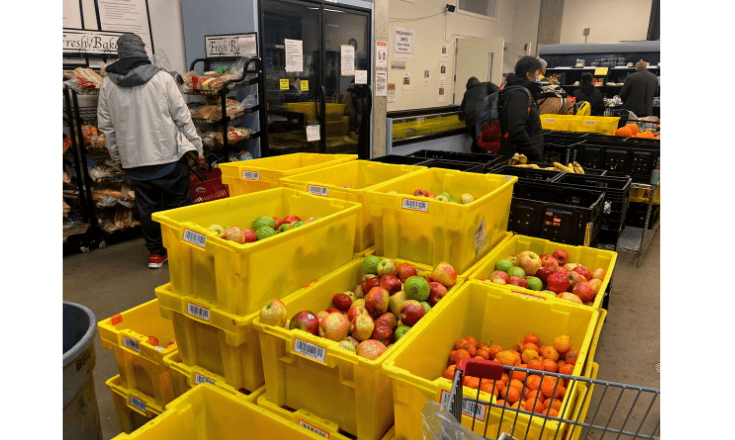One thing I wish I had known of sooner when moving to Seattle as an international student was the existence of food banks and pantries around the city. Recently, I started frequenting the University District (U District) Food Bank, located at 5017 Roosevelt Way NE, once a week, and it has immensely helped me navigate life as a low-income foreign student in the United States. At the bank, apart from canned and non-perishable goods, there is fresh produce, meat, eggs, dairy, bread, sweets, condiments, and a section of products exclusive for those who don’t have access to cooking facilities. They also provide certain hygiene products, baby formula, diapers, and dog food and care.
There are so many people struggling around us, and most times we do not know what their personal lives are like. I believe the knowledge of programs like this can benefit so many more people. For this reason, I spoke to a former worker of the U-District food bank, Nora, who worked as a home-delivery coordinator.
Nora tells us that she became involved with the work through AmeriCorps, a national service coalition related to the Peace Corps. “You work for a year at a non-profit, and usually you work in some sort of program management … So I applied for a couple of jobs across the country [listed] there, and I was really interested in food systems, so I decided to work at the food bank.”
Regarding the functioning of the bank itself, I asked where the food and produce come from, and how those agreements work between the provider and the institution. Nora said, “About 70% of the food comes from [a] grocery with a relationship to the bank … [agreements such as] grocery rescue, [where] staff picks up food that’s expired, or that they can’t legally sell; 30% comes from donations: Food Lifeline, Northwest Harvest.”

As to the food bank’s staffing, Nora said, “It’s a very small organization. In terms of staff, about 15 people who help customers, restock, do delivery … Most of the work is done by volunteers.”
A worry of mine when I first learned of the existence of these support organization was the requirements for one to be able to receive the services. For example, are documents such as proof of income, proof of number of household members, or American citizenship required? “When I worked there, anyone can walk up and you don’t have to provide any proof of income or identity or anything. You’ll just come up, fill out a form, write your name down and address if you have one. And that’s mostly just for reporting to the city. But, yes, anyone can come up and get food,” clarified Nora, adding that “before COVID, it was limited to certain zip codes … There are a bunch of food banks in the city, and they all have their own jurisdiction, so pre-COVID we only served people in six different zip codes, but then we decided to open it up to anyone.”
Nora shared, “I managed a home-delivery program … which is a program for disabled people and seniors, so I had great conversations every week with people. Seniors always like to talk. The volunteers are just insanely dedicated, some of them are in there 20 hours a week.” When asked about the daily number of people who benefitted from the service, she says around 200 to 300, “but a lot of people come around by themselves, and they shop for bigger families, so it might seem like there are less people there, but they’re shopping for a lot of people.”
When I shared how long it took for me to understand that these food banks existed and how they worked, Nora cleared things up: “I think not enough people know about it. Food banks are very strange in Seattle because in most cities in America, there is one big food bank and then pantries to which they distribute food to, so it’s very centralized and you can find information on where all the food is in the city… but here, all the food banks are independently run, so there isn’t any big guide with resources that these food banks provide, which can be hard to navigate.”

When you first walk in, an attendant will provide you with a form (if it is your first time), which asks for your name and number of household members. Next, they will register you into the system and hand you a flyer with an inventory table containing the amount of each product (fresh produce, canned protein, drinks, dairy, meat, eggs, etc.) that you may take, according to the number of people in your household and if you have access to cooking facilities. At the end, another person will help you put your groceries into a paper bag, or fit them into your own bag if you bring one. Anyone, regardless of documents, formalities, or citizenship, can frequent Seattle’s food banks and get the appropriate amount of products needed.
If you’d like to find a food bank near you, here is a resource by the Seattle Food Committee which shows you where each organization is located in the city, and more information about how to access them, as well as how to donate or volunteer. If you wish to know more or get involved with the U-District food bank, either by volunteering or donating, you can find information on how to do so here.
Author

Sophia is an internationally published author with her book Primeira Pessoa, as well as a young classical singer. Born and raised in Brazil, she believes the greatest role of a writer is to bring forth the truth, the honesty, and the humanity that echoes within each one of us.







Be First to Comment